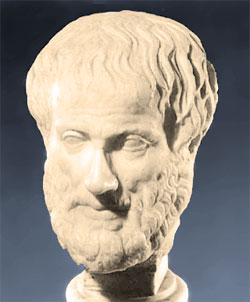Reading the Five Ways
8. The third Way
 In the 1980 film Somewhere in Time, a young actor is handed a pocket-watch by an elderly female stranger. He later discovers that she had been a famous actress decades before, and (this being cinema) discovers a way to travel back in time to meet her as a young woman.
In the 1980 film Somewhere in Time, a young actor is handed a pocket-watch by an elderly female stranger. He later discovers that she had been a famous actress decades before, and (this being cinema) discovers a way to travel back in time to meet her as a young woman.
When he finds her, he gives her the same pocket watch that she (decades in the future) will give back to him. The watch therefore ‘loops’ around in time. There’s no point at which it is manufactured: it simply is. And yet there is something deeply odd about that, and you can’t help feeling that the watch’s existence is unintelligible.
If, when watching the film, you feel that sense of unintelligibility, Aquinas (like an old-style cinema usherette) will be there to offer you some concepts for making sense of that feeling. (But please remember: the concepts that he offers have nothing to do with Paley’s design argument: that was a different watch altogether).
The watch, Aquinas would say, is contingent, in that it is quite possible that the world could have contained no such watch; it is possible for the watch not to be. And yet the watch is, and therefore there must be some reason why it is – even if (in this imaginary case) we can’t quite get that question into a straightforward causal and temporal form.
This is brilliant stuff – but there is a real problem in Aquinas’ way of weaving these concepts into his third argument. He sets up the idea of contingent existence (the existence of things that need not exist, whose existence requires explanation; things whose existence depends on something other than themselves) – and so seems to have set up the possibility of yet another kind of ‘chain’ linking the facts of the world into intelligible order. But in the event, Aquinas does not run a version of the argument he has used in the first two Ways. Instead, he says
a thing that need not be, once was not; and if everything need not be, once upon a time there was nothing. But if that were true there would be nothing even now, because something that does not exist can only be brought into being by something already existing. (1a.2.3)
I’ll leave the translation, interpretation and criticism of that version of the argument to the experts (you know, the people who actually know what they’re talking about). It seems to me that, instead of following the details of Aquinas’ presentation, we can take this third Way as a regression just like the first two – and, if we do, I think it provides the most powerful argument of the three, because it asks the most basic ‘Why?’ question of all. Faced with some reality in the world, it doesn’t ask, ‘Why does this change in the way that it does?’ nor ‘Why does it act in the way that it does?’ but ‘Why is it there at all?’
The third Way recognises that nothing in the world is sufficient in itself to answer all the questions we might have about it – so some of our questions will always take us beyond the object in question. And it recognises that the world itself is insufficient to answer all our questions about it. The world leaves us asking, at very least, Why is there something rather than nothing? – and (to Aquinas at least) the world does not seem itself to be capable of providing any answer to that question.

 If you want to get a clear mental picture of what the first Way says about the world, it is worth noting that the chains that Aquinas joins together are not necessarily in themselves temporal (even though each link in the chains is itself a temporal change). Aquinas is not presenting a picture of each new change depending upon some other change that took place some time before. Rather, he pictures the world as something more like a clock: the hands move because the spindle they are attached to moves; that spindle moves because this cog moves; this cog moves because that one does; that one does because the escapement mechanism moves; the mechanism moves because the pendulum moves: the clock as a whole is an ordered set of interlocking movements and dependencies.
If you want to get a clear mental picture of what the first Way says about the world, it is worth noting that the chains that Aquinas joins together are not necessarily in themselves temporal (even though each link in the chains is itself a temporal change). Aquinas is not presenting a picture of each new change depending upon some other change that took place some time before. Rather, he pictures the world as something more like a clock: the hands move because the spindle they are attached to moves; that spindle moves because this cog moves; this cog moves because that one does; that one does because the escapement mechanism moves; the mechanism moves because the pendulum moves: the clock as a whole is an ordered set of interlocking movements and dependencies.  Aquinas is able to see his world as an intelligible one because he looks through a lens polished by certain concepts. Those concepts help him articulate the world’s intelligibility.
Aquinas is able to see his world as an intelligible one because he looks through a lens polished by certain concepts. Those concepts help him articulate the world’s intelligibility. Imagine that you were walking across a foggy field, and suddenly found an iron chain dangling in front of you. The fog prevents you from seeing very high, but it is clear that the bottom link of the chain is dangling a foot or more above the ground. You can see that the bottom link is suspended from the second, the second from the third, and so on up to about the fiftieth – which is as far as you can see. You know, however, that the fiftieth link up must itself be suspended from something – and the chain seems securely suspended when you tug sharply downwards on it. Curious (and foolhardy), you climb a little way up the chain, and find that the fiftieth link is indeed suspended from the fifty-first, the fifty-first from the fifty-second, and so on and so on, as far up as you feel capable of climbing. You let yourself carefully back down to the ground.
Imagine that you were walking across a foggy field, and suddenly found an iron chain dangling in front of you. The fog prevents you from seeing very high, but it is clear that the bottom link of the chain is dangling a foot or more above the ground. You can see that the bottom link is suspended from the second, the second from the third, and so on up to about the fiftieth – which is as far as you can see. You know, however, that the fiftieth link up must itself be suspended from something – and the chain seems securely suspended when you tug sharply downwards on it. Curious (and foolhardy), you climb a little way up the chain, and find that the fiftieth link is indeed suspended from the fifty-first, the fifty-first from the fifty-second, and so on and so on, as far up as you feel capable of climbing. You let yourself carefully back down to the ground. In Chapter 3 of The God Delusion Dawkins seeks to dispose of supposed proofs for the existence of God. He turns his attention first to the famous ‘Five Ways’ of Thomas Aquinas. And I’m afraid that this is one of those points where I simply can’t be polite about Dawkins. His presentation is just dreadful. It reads like it is cribbed from a passing schoolboy – one who wasn’t listening in the relevant class, and so had to cobble together an essay based on a reading of a text some way beyond his limited intellectual level. Since Dawkins is clearly not that stupid, I can only assume that he, knowing in advance that he’s right and that people who disagree with him are wrong, simply didn’t think it worth bothering trying very hard to understand something written in a somewhat foreign idiom.
In Chapter 3 of The God Delusion Dawkins seeks to dispose of supposed proofs for the existence of God. He turns his attention first to the famous ‘Five Ways’ of Thomas Aquinas. And I’m afraid that this is one of those points where I simply can’t be polite about Dawkins. His presentation is just dreadful. It reads like it is cribbed from a passing schoolboy – one who wasn’t listening in the relevant class, and so had to cobble together an essay based on a reading of a text some way beyond his limited intellectual level. Since Dawkins is clearly not that stupid, I can only assume that he, knowing in advance that he’s right and that people who disagree with him are wrong, simply didn’t think it worth bothering trying very hard to understand something written in a somewhat foreign idiom.
Recent Comments